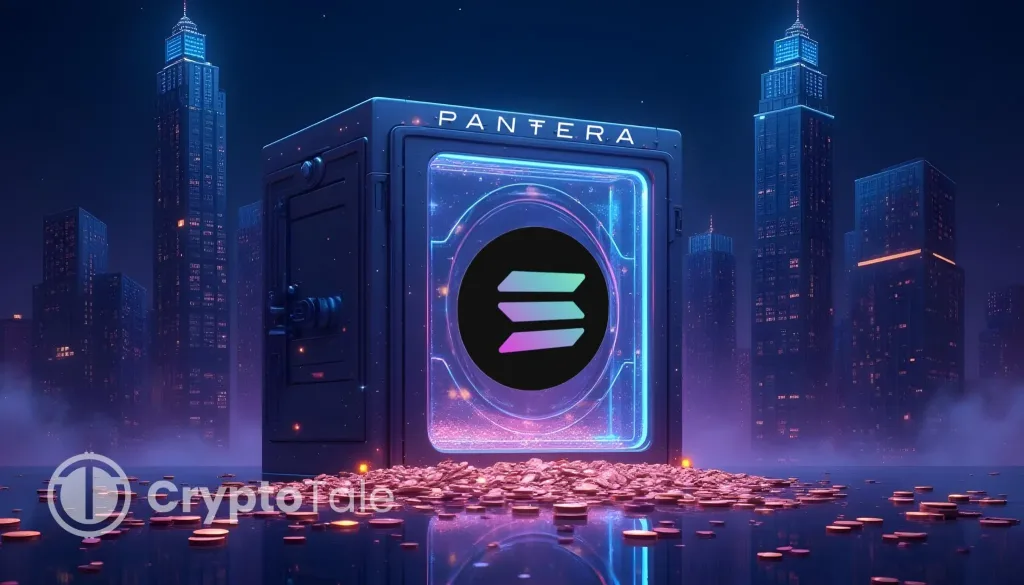Pantera Eyes $1.25B to Build a Solana Public Investment Firm

- Pantera Capital plans a $1.25B raise to build a Nasdaq-listed Solana treasury company.
- The firm would create one of the largest public reserves of SOL held by institutions.
- Public Solana treasuries now hold 3.71M SOL worth $700M, signaling rising corporate demand.
Pantera Capital is preparing a $1.25 billion plan that could reshape Solana’s place in institutional markets. The firm intends to convert a Nasdaq-listed company into a Solana treasury vehicle. According to sources, Pantera will start with a $500 million raise before issuing $750 million in warrants. The target company would be renamed “Solana Co.” and positioned as a public vehicle to hold Solana tokens.
Pantera has already invested heavily in digital asset treasury projects. Earlier this month, the firm revealed it deployed around $300 million into treasury firms across multiple cryptocurrencies. Its portfolio spans eight tokens, including Bitcoin, Ethereum, Solana, BNB, Toncoin, Hyperliquid, Sui, and Ethena.
In its blockchain letter, Pantera stressed that a digital asset treasury’s success depends on the long-term strength of the underlying token. The firm expects treasury firms to generate yield while growing net asset value through token accumulation.
Furthermore, earlier this week, Pantera joined ParaFi Capital in backing Sharps Technology, a Solana treasury vehicle seeking to raise more than $400 million. That deal added to Pantera’s growing list of treasury-focused bets, including Twenty One Capital and DeFi Development Corp, underscores its commitment to positioning Solana as a cornerstone of institutional crypto adoption.
Solana’s Expanding Treasury Market
Pantera’s push comes as other major firms also build Solana treasuries. Galaxy Digital, Jump Crypto, and Multicoin Capital are jointly raising $1 billion for a Solana-focused reserve. Others, such as Upexi and DeFi Development Corp, have also added Solana through equity raises. Upexi now holds over 2 million SOL, the largest single corporate reserve on record.
As per CoinGecko data, the total size of the public Solana treasuries is about 3.71 million SOL, which is worth around $700 million, representing 0.69% of the total supply of Solana tokens. This steady accumulation points to the structural force of demand, as institutions consider Solana as a long-term portfolio asset.
Pantera’s planned raise would mark the largest corporate Solana treasury to date. The firm aims to establish Solana Co. as a flagship public entity by combining equity capital and warrants. The model indicates the change in the way digital assets enter the traditional markets. Instead of ETFs, treasury firms accumulate tokens directly and grow their reserves over time.
Related: Institutional Solana Staking Yields Boost Market Confidence
The strategy also mirrors Strategy’s Bitcoin playbook. Strategy began accumulating Bitcoin in 2020, positioning itself as a public proxy for exposure. Pantera now appears to be building the same model for Solana, potentially giving Wall Street a new entry point.
If Pantera’s $1.25 billion initiative succeeds, it would tighten Solana’s circulating supply. Combined with parallel treasury projects, this could create long-term price resilience. More importantly, it would legitimize Solana as an institutional-grade asset class.
The move towards Solana-related corporate organizations marks a turning point in digital assets. At press time, Solana (SOL) traded at $188.96, ranking at 6th place among cryptocurrencies. The token recorded a 4.96% gain over the past week, with a market cap of $102.14 billion.
The post Pantera Eyes $1.25B to Build a Solana Public Investment Firm appeared first on Cryptotale.
Disclaimer: The content of this article solely reflects the author's opinion and does not represent the platform in any capacity. This article is not intended to serve as a reference for making investment decisions.
You may also like
Incubator MEETLabs launches large-scale 3D fishing blockchain game "DeFishing" today
As the first blockchain game on the GamingFi platform, a dual-token P2E system is implemented using the IDOL token and the platform token GFT.

A History of Privacy Development in the Crypto Space
Privacy technologies in the crypto world have never truly broken free from the limitations of being "narrow" and "single-user."
Trading volume surpasses 410 millions, Sun Wukong's first phase "trade mining" report released, excess fee rebates ignite the market
Currently, the first phase of the Sun Wukong trading mining activity has entered its second half. The event will officially conclude at 20:00 (UTC+8) on December 6, 2025.

